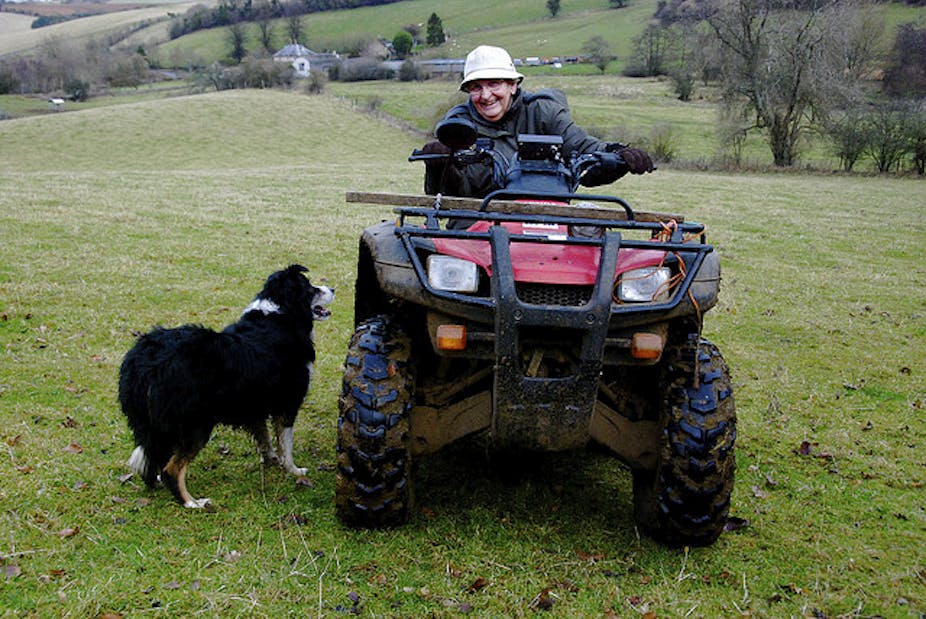The tragic quad-biking death of an 11-year-old boy from northwest Victoria on Monday takes the 2011 death toll from all terrain vehicle (ATV) accidents to 17.
The boy reportedly died after his ATV overturned while he was herding cows.
This accident shouldn’t have happened but it’s part of a growing trend of injury and deaths associated with these widely-used farming vehicles.
Data from the University of Sydney’s Australian Centre for Agricultural Health and Safety shows the number of deaths from the use of these vehicles has risen in the past decade from around eight to 10 a year, to 14 deaths in 2010.
The industry continues to recommend their traditional rider-education program as the panacea to the problem.
But while I’m unaware of any Australian evaluations of these programs, they seem to be having little effect on safety.
Design flaws
Around 280,000 ATVs are currently in use in Australia and the number is rapidly rising. Their popularity is based on their accessibility, ease of use, and low maintenance – they’re effectively substitutes for horses for all manner of farming and recreational needs.
No one denies their functionality and usefulness. But the industry is yet to update their design to improve their crashworthiness and handling.
The problem is that quad bikes can roll over and crush the driver, which highlights the need for crush protection devices (CPD) or rollover protection systems (ROPS) to save lives.
Researchers have found around half of ATV fatalities are associated with rollovers – a figure that, surprisingly, is disputed by some manufacturers.

Reducing the risks
The Victorian WorkCover Authority commissioned Monash University to study ATV injuries and deaths following a Victorian Coronial inquest into ATV deaths in 2003.
The authors designed a crush-protection device, which comprised of a protective structure and an occupant-restraint system – basically, a seat structure with profile sides and head rest and four-point seat belts.
The study evaluated the design using computer modelling for both moderate and severe lateral rollovers and found it provided good protection in such incidents.
The Monash report recommended further industry-supported research to come up with an ATV design that had full rollover protection systems and restraints, that reduced rollover propensity while providing for active riding to meet farmers’ needs.
But the manufacturers chose not to accept the recommendation.
Instead, they hired legal teams and United States product litigation defence experts, including John W. Zellner from Dynamic Research Incorporated (DRI), to evaluate the Monash design at considerable cost (in the order of many hundreds of thousands of dollars).
DRI based its analysis on 113 very scantily described, two-line descriptors of ATV incidents, a large number of which didn’t even involve a rollover.
It claimed the Monash design caused more injuries than an ATV without a rollover protection system.
Study flaws
The manufacturers claim the DRI study as the main reason for not fittings rollover protection systems or even considering crush protection devices.
What they don’t mention is all Australian rollover safety research experts agree the DRI analysis is fundamentally flawed in its cost-benefit logic and modelling.
The analysis equated either 111 non-injuries, or 15 scrapes and bruises, or 5½ non-critical fractures (broken arm or rib) to one fatality.
But, of course, death and minor injury aren’t comparable – the goal must be to eliminate deaths altogether.
The analysis also contained around 150 basic modelling errors of the 113 cases, rendering it biased and totally inaccurate.
But we shouldn’t be surprised. This strategy is often implemented by industries to infuse doubt among legislators, who consider regulation that would potentially cost industry many millions of research and development dollars to find a solution.
Such doubt-mongering has been shown to be effective in delaying the inevitable legislation that mandates safety or restricts harmful products.
What can we do as consumers?
We need a joint research program, with industry and researchers, to find a solution. Though it seems unlikely manufacturers will come to the party – they haven’t so far.
But there is hope. If regulators created a program simular to the Australian New Car Assessment Program (ANCAP), manufacturers would be forced to publish crash tests results. This would increase education for customers, and name and shame the manufacturers of unsafe vehicles.
This type of All Terrain Vehicle Assessment Program (ATVAP) could include three tests which would assess ATV safety in risky situations: a climb up a hill where the ATV rolls backwards, a side rollover down an incline, and a frontal crash.
If we rated the vehicles based on these three tests and published the results, consumers could make an informed decision about whether the vehicle they owned or were considering buying was safe. If it was found to not be safe, sales would likely dry up.
This relatively simple measure could apply the pressure the industry needs to improve ATV safety and prevent more deaths and serious injuries.
This article was co-authored by Dr George Rechnitzer, an engineer from Rechnitzer and Associates.

